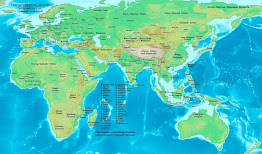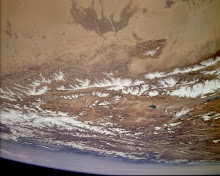It is imperative in the light of the despicable and opportunistic blatantly illegal and null and void so-called border agreement entered by the Rogue Chinese State which illegally and militarily occupies the sovereign states of the Republic of East Turkistan and Tibet for the Government of the Republic of India to convene a meeting of the authorized representatives of the De Jure Government in- Exile of the Sovereign State of East Turkistan and hold deliberations and demarcate the International Boundary of India with the Republic of East Turkistan, our historic neighbour. The Prime Minister of Occupied East Turkistan, Salih Hudayar has also reiterated that Aksai Chin 36°40'41"N 78°26'34"E in Ladakh and the Cis-Kuen Tract in northern Kashmir are an integral and inalienable part India. India as a self-respecting and sovereign
Nation which is not subservient and servile to any ought to have done it then and there on 2nd march 1963 itself when the Rogue Regime in China signed the treacherous and deceitful opportunistic illegal so-called border agreement with the Pakistanis pertaining to territory which is a part of India.
The Draft text of the proposed agreement to be inevitably signed
is as follows:-
The Government of the Republic of India and the Government-In-Exile of The Sovereign Republic of
 |
| Opening of the ETGE's 8th General Assembly in Washington, DC on November 10, 2019 |
Have resolved for this purpose to conclude the present
agreement and have appointed as their respective plenipotentiaries the
following.
For the Government of the Republic of India, Minister
of Foreign Affairs.
For the De Jure Government of the Republic of East
Turkistan, Minister of External Affairs.
Who, having mutually examined their full powers and found
them to be in good and due form have agreed upon the following:-
Article 1. In view of the fact that the historical boundary between the Trans Kuen Lun state of East Turkistan and the
contiguous areas in the adjoining Highlands of Kashmir comprising the areas of former
principalities of Ladakh or Maryul and Kanjut adjoining the Trans Kuen Lun State of East
Turkistan on the Kuen Lun Range Border has never been formally delimited,
two parties agree to delimit it on the basis of the traditional customary
boundary line including features and in a spirit of equality, mutual benefit
and friendly cooperation.
Article 2. In accordance with the principle expounded in Article 1 of the present agreement, the two parties have fixed as follows the alignment of the entire boundary line between The composite Cis- Kuen Lun State of Kashmir comprising the Highlands of Kashmir from the edges of the Highlands of Kashmir on the Kuen Lun Range to the area of Kathua in Jammu which legally acceded to the Union of India and the Trans-Kuen Lun State of East Turkistan. The Republic of East Turkistan endorses and acknowledges the fact that the province of Kashmir is geographically a highlands province and hence
has two types of mountain Ranges which comprise part of the province. One the Main or Internal Mountain Range which is insofar as Kashmir is concerned is the Karakoram Mountain Range and the second, the Mountain Range at the edge of the Highlands of Kashmir which is insofar as Kashmir is concerned is the Kuen Lun Range and the historical Inter-national Boundary between India and East Turkistan has always historically been on the Mountain Range on the Edge of the Highlands of Kashmir viz.1. Commencing from its north-western extremity in the area of Dafdar in the Taghdumbash Pamir, the northernmost part of the Republic of India, the boundary line runs from the northwest of Dafdar on
the line of water parting of the Kuen Lun Range separating the Tashkurghan River from the Mariong River and continues on the point of water Parting on the Kuen Lun Range via Zangar, Chang, Sargon, Mamkol and Yashrab Passes and then crosses the Raskam River and continues on the line of the water parting separating the Raskam River system including the tributaries of the Raskam River inside the highlands of Kashmir viz. inter alia the Kukalang and Kulanaldi Rivers of the Raskam River System inside Kashmir which flows in Kashmir and enters East Turkistan in the area of Sanglash from inter alia the Ishakbulak, Tizuaf, Pokhpu, Dona Ustang, Achik, Tiznaf, Kokyar or Kilian Rivers which have its source on the Kuen Lun Range and flows north into the Takla Makan desert in the Tarim Basin in East Turkistan2 The International Boundary will continue on the line of the water parting of the Kuen Lun Range and
pass through the Mountain Passes on the Kuen Lun Range separating India from East Turkistan like inter alia the Kukalang Pass, the Chirag Saldi Pass, the Yangi Pass, the Kilian Pass and the Sanju-La Pass.3 From the aforesaid point of the Sanju-La Pass, the Inter-national boundary line runs from the Sanju-La Pass and crosses the Kara Kash River at a point east of Ali Nazar in Ladakh and runs on the Hindu-tash Ridge which is a spur of the Kuen Lun Range to the historic Hindu-tash Davan Pass in Ladakh and thence continues eastward on the Kuen Lun Range on the line (point ) of the water parting separating the Qara Qash and the Yarung Kash from the rivers flowing north from the Kuen Lun Range like inter alia the Sanju, Pusha, Kashka Oghil, Genju, Nura, Karasu and Pisha Rivers.
5 Thence, the boundary line continues and culminates at Pulu where the Kuen Lun Range in Kashmir and the Altyn Tagh Range on the edge of the Plateau of Tibet converge. Running southwest to northeast, the Altyn Tagh converges with the Kunlun range in Kashmir which runs southeast to northwest forming a "V" shape which converges at Pulu.
Article 3 . The two parties have agreed that:
i) The boundary follows the Kuen Lun Range, the water-parting line of the Kuen Lun Range dividing the rivers systems flowing into the Raskam, Kara Kash, and the Yurung Kash River Systems inside Kashmir on one side from the Rivers flowing north from the Kuen Lun Range to the Tarim Basin in East Turkistan .
ii) Wherever the boundary passes through a Davan (Pass) the water-parting line thereof shall be the boundary line.
Article 4. One, the two parties have agreed to set up, as soon as possible, a joint boundary demarcation commission. Each side will appoint a Chairman, one or more members and a certain number of advisers and technical staff. The joint boundary demarcation commission is charged with the responsibility in accordance with the provisions of the present agreement, to hold concrete discussions on and carry out the following tasks jointly.
1) To conduct necessary surveys of the boundary area on the ground, as stated in Article 2 of the present agreement so as to set up boundary markers at places considered to be appropriate by the two parties and to delineate the boundary line of the jointly prepared accurate maps.
To draft a protocol setting forth in detail the alignment of the entire boundary line and the location of all the boundary markers and prepare and get printed detailed maps, to be attached to the protocol, with the boundary line and the location of the boundary markers shown on them.
2) The aforesaid protocol, upon being signed by representatives of the governments of the two countries, shall become an annex to the present agreement, and the detailed maps shall replace the maps attached to the present agreement.
3) Upon the conclusion of the above-mentioned protocol, the tasks of the joint boundary demarcation commission shall be deemed to have been terminated.
Article 5. The two parties reiterate that any doubts concerning the boundary which may arise after the delimitation of the boundary line actually existing between the two countries shall be resolved peacefully and amicably by the two parties through friendly consultations.
Article 6. The two parties have agreed that after the inevitable independence of the sovereign State of East Turkistan, the de Jure Government of the independent and sovereign State of East Turkistan and India, will reiterate and uphold the Preliminary agreement signed by the de Jure Government of the Sovereign Republic of East Turkistan-in-Exile as stated in Article 2 and ratify and confirm and sign a formal boundary treaty to replace the present preliminary agreement signed by the de jure Government of East Turkistan in Exile.
Article 7 . The present agreement shall come into force on the date of its signature.
Done in triplicate in Berlin , Washington and Nav Dehli on the second day of August 2021, in the Uighur, Hindi and English languages, all the versions being equally authentic.





1 comment:
Sir in wikipedia article about extreme points of India in 2017, they displayed that 37°24′00″N 75°24′00″E(north of Dafdar) is the northernmost point claimed by india but later deleted it. Sir, if possible can you pls upload a map depicting the above given coordinate as our northernmost point .
Even Aurel stein published a similar geographical map. Even in old maps of ladakh on northern frontiers and wikimedia websites depict hindu tash region
Post a Comment